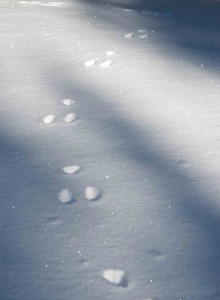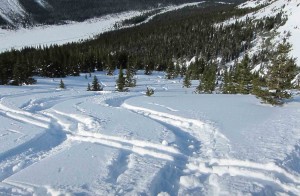I’ve often heard that the Inuit have hundreds of words that describe snow. Deciding to write a bit about snow, I was looking up just how many words they do use. I discovered in fact the language allows for the construction of words ‘on the fly’ and this feature of the Inuit spoken word makes it seem like there are many words that describe snow and anything else for that matter. As far as I can determine, they use about as many words as the English do but they are able to construct words as needed to describe things like ‘snow in hair’ or ‘snow with dogs paw prints’ if the need should arise. Have a look at http://ontology.buffalo.edu/smith/varia/snow.html where Phil James outlines a few phrases that the Inuit are able to condense into one word.
As I skied the last few days I noticed how different snow can be. In the back country we ski uphill. As we ascend, each of us will take a turn ‘breaking trail’. As I walk and slide through the snow I pass through soft dry fluffy snow, dense wind blown snow, thick wet snow, snow that lets me penetrate 30 cm, snow I sink 60 cm into and snow that I am able to glide on the top of. As I walk over this snow I am constantly trying to see, feel, or otherwise perceive changes. Any change is important to note and discuss with my fellow travelers. These changes may indicate the presence of unstable snow, not something I want to encounter while moving across avalanche prone terrain. Often I follow 4th or 5th in the line of skiers. By that time the snow along our uptrack is quite solid, compacted and smooth. The skis glide quite well and the movement is easy.
 Visually the snow can be quite stunning. New untracked snow will sparkle and glisten in the sunlight. It looks like a big down comforter, soft and enticing. The wind can sculpt the surface and it can look like a frozen ocean with rolling waves and white caps. On cold clear nights the crystals transform into hoar frost leaving tall crystalline pinnacles standing in clusters that collect sunlight and shimmer like jewels tossed randomly on the ground. I also try to take note of these visual changes in the snow as well. The hoar frost that formed over the last couple of nights will be unstable later in the season. Any new snow will not bond to the lower layers and the new snowfall will be more likely to slide. The avalanche reports will tell me this but it is good to have my own knowledge base.
Visually the snow can be quite stunning. New untracked snow will sparkle and glisten in the sunlight. It looks like a big down comforter, soft and enticing. The wind can sculpt the surface and it can look like a frozen ocean with rolling waves and white caps. On cold clear nights the crystals transform into hoar frost leaving tall crystalline pinnacles standing in clusters that collect sunlight and shimmer like jewels tossed randomly on the ground. I also try to take note of these visual changes in the snow as well. The hoar frost that formed over the last couple of nights will be unstable later in the season. Any new snow will not bond to the lower layers and the new snowfall will be more likely to slide. The avalanche reports will tell me this but it is good to have my own knowledge base.
We were XC skiing across Lake Louise and encountered several changes in the snow. As we moved away from the Chateau to the south we skied across loose fairly new snow, totally glazed sections that must have been snow with a substantial amount of moisture, and a couple of sections of out and out ice. Each time we encounter a change in the snow we had to adapt our skiing style to suit what was under foot. Crossing the snow sections we could use diagonal stride and we moved quite smooth with a minimum of effort. Over the glazed sections we had to be aware of our timing and had to make sure we were propelling our selves forward exactly when our grip wax engaged the snow. Over the icy sections, where small streams entered the lake, we had to double pole and it made for a high speed traverse across the sketchy portions of the trail.
There is also an audible aspect to snow travel. As we skied across the icy sections of the Lake Louise XC track our skis rattled and clacked. Sometimes the snow squeaks. When skiing the groomed slopes encountered at most resorts I can tell how well I’m skiing by the amount of noise my skis are making. I also listen for a change in the sound which indicates a change in the surface that I am crossing. In the backcountry I constantly listen to the snow and again try to determine it’s story. A ‘woomph’ or a thump is a sign that the snow is not stable and maybe it would be a good idea to vacate the area. Often I will hear the thundering sound of an avalanche on some other ridge or mountain. We look around and see if we can spot the source of the thunder and determine what kind of slope it was on, what the aspect of the slope is, what might have caused the snow to slide and if any of these factors may be at play into our days skiing plans.
I walk up the mountain to ski down. Some folks will tour just for the serene experience, but without the skiing I don’t think I would spend so much time in the wilderness. It is when I ski down that I am most aware of the texture of the snow. When I lived in Whistler we would ski new snow that was affectionately known as pig or elephant snot. It was wet, and dense. Not having ever handled elephant snot I can only assume that it would be of the same texture. It was hard to ski because it took an incredible amount of strength just to turn my skis, but at the same time it was easy because the resistance was so great controlling speed was not an issue. Farther east, in the Rockies, the ultimate skiing is in ‘champagne powder’, snow so dry and soft that as you ski it billows and puffs enough to obscure your vision. There is snow that is a pain to ski. The wind pounds the surface until there is a hard crust 5 or 10 cm thick. Strong enough to hold your weight until you turn your skis downhill, then you break through, you float back to surface and ski along not knowing when you are going to break through again. There are times when the slopes are scoured so clean that you may as well be skiing on ice. Sometimes although the texture of the snow is great, the coverage is uneven and the subsurface objects become hazards making for a very tentative run down. This week we were skiing in snow that felt like sugar. It was boot top to knee deep and had a very silky feel as we descended. The only interruption to the smooth, floating feeling was the occasional protrusion of a wind scoured mound that the new snow had settled around and left an impenetrable surface to ski up and over.
I don’t know exactly how many words the Inuit have for snow but I would sure like to have access to a few more than I have. The writing of this blog would have been much more precise and I could surely entertain my skiing partners with my knowledge of a material that is such an integral part of our lives.


